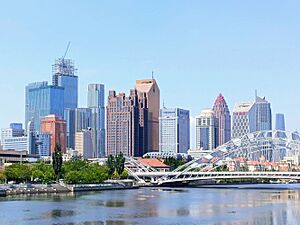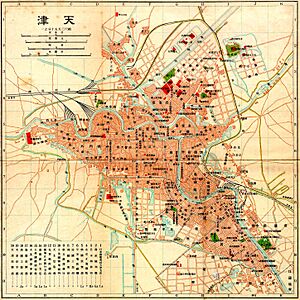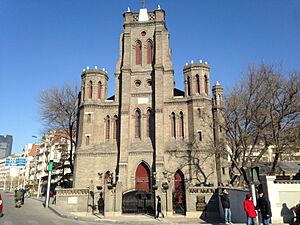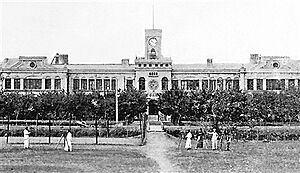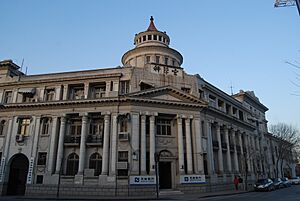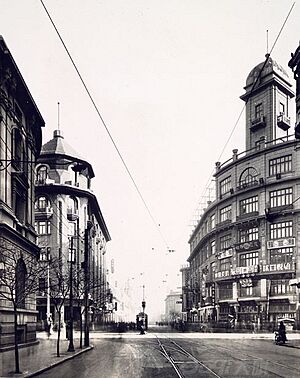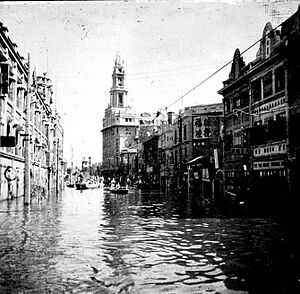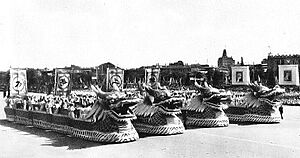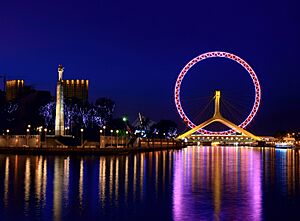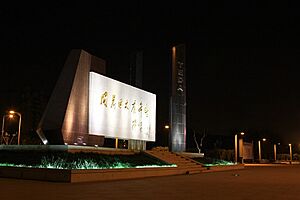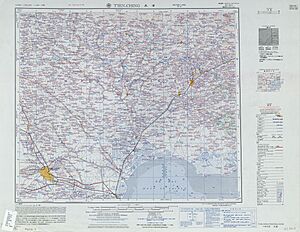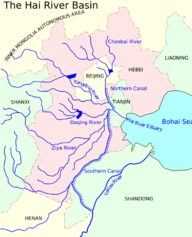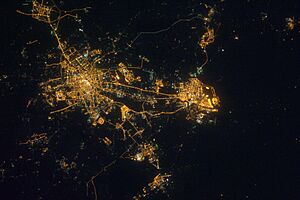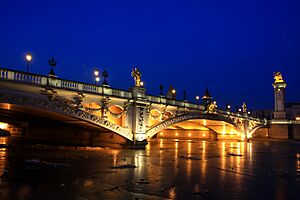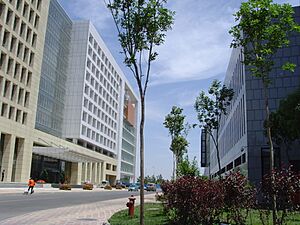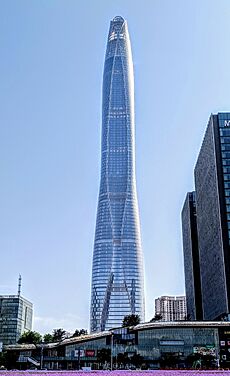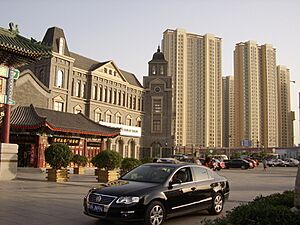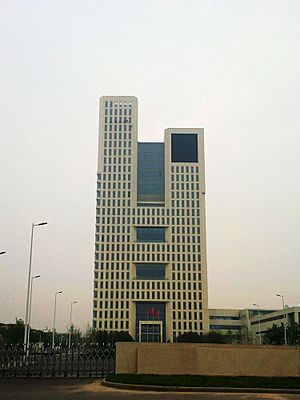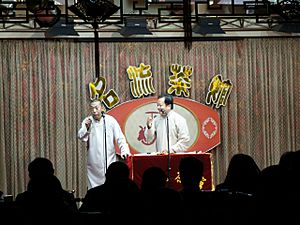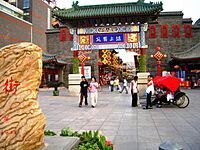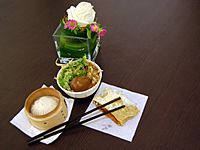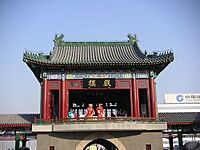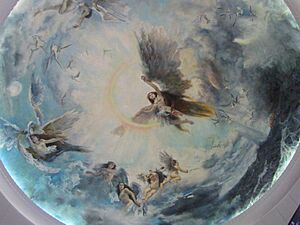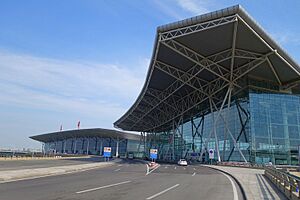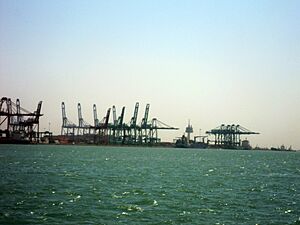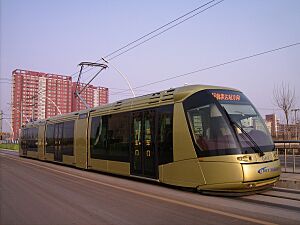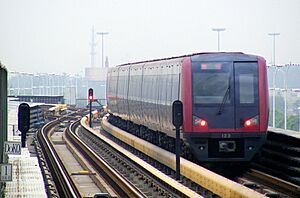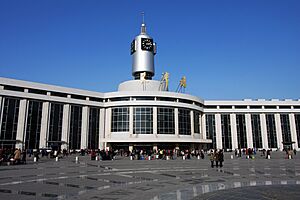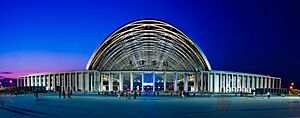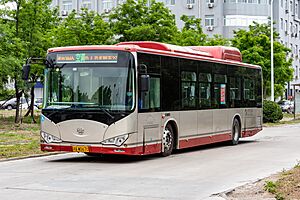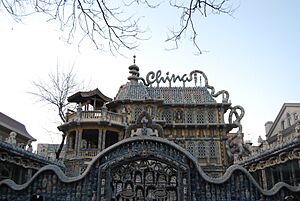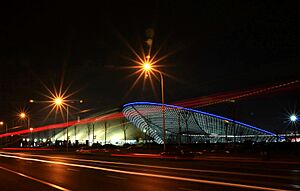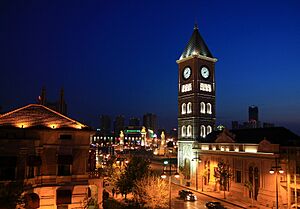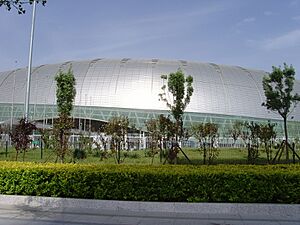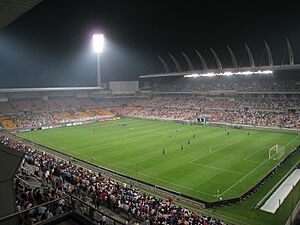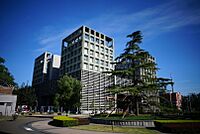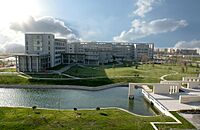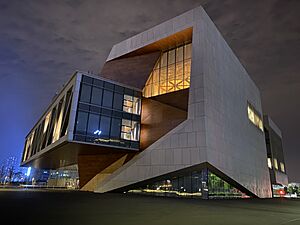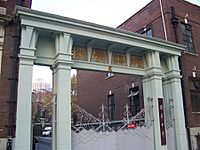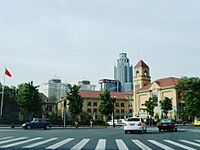Tianjin facts for kids
Quick facts for kids
Tianjin
天津
Tientsin
|
|||||||||||
|---|---|---|---|---|---|---|---|---|---|---|---|
|
Municipality
|
|||||||||||
| Municipality of Tianjin | |||||||||||
|
Tianjin Eye on the Hai River
Binhai New Area
Mount Pan
Huangya Pass
Tianjin railway station
Minyuan Stadium
Tianjin Concert Hall
|
|||||||||||
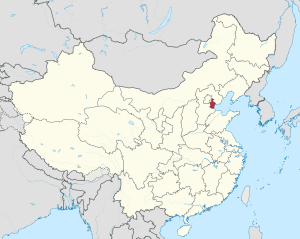
Location of Tianjin Municipality within China
|
|||||||||||
| Country | China | ||||||||||
| Settled | c. 340 BC | ||||||||||
| Municipal seat | Hexi District | ||||||||||
| Divisions - County-level - Township- level |
16 districts 240 towns and townships |
||||||||||
| Government | |||||||||||
| • Type | Municipality | ||||||||||
| • Body | Tianjin Municipal People's Congress | ||||||||||
| Area | |||||||||||
| • Municipality | 11,946 km2 (4,612 sq mi) | ||||||||||
| • Land | 11,609.91 km2 (4,482.61 sq mi) | ||||||||||
| • Water | 186 km2 (72 sq mi) | ||||||||||
| • Urban | 11,609.91 km2 (4,482.61 sq mi) | ||||||||||
| • Metro | 5,609.9 km2 (2,166.0 sq mi) | ||||||||||
| Elevation | 5 m (16 ft) | ||||||||||
| Highest elevation
(Jiushan Peak)
|
1,078 m (3,537 ft) | ||||||||||
| Population
(2020 census)
|
|||||||||||
| • Municipality | 13,866,009 | ||||||||||
| • Density | 1,160.72/km2 (3,006.26/sq mi) | ||||||||||
| • Urban | 13,866,009 | ||||||||||
| • Urban density | 1,194.3253/km2 (3,093.2883/sq mi) | ||||||||||
| • Metro | 11,165,706 | ||||||||||
| • Metro density | 1,990.357/km2 (5,155.00/sq mi) | ||||||||||
| Demonym(s) | Tianjinese Tianjiner |
||||||||||
| nominal GDP | |||||||||||
| • Total | CN¥ 1,674 billion (24th) US$ 238 billion |
||||||||||
| • Per capita | CN¥ 122,752 (6th) US$ 17,420 |
||||||||||
| Postal code |
300000 – 301900
|
||||||||||
| Area code(s) | 22 | ||||||||||
| ISO 3166 code | CN-TJ | ||||||||||
| HDI (2022) | 0.858 (3rd) – very high | ||||||||||
| Vehicle registration | 津A, B, C, D, F, G, H, J, K, L, M 津E (taxis) |
||||||||||
| Abbreviation | TJ / Chinese: 津; pinyin: jīn | ||||||||||
| Climate | Dwa/BSk | ||||||||||
|
|||||||||||
| Tianjin | |||||||||||||||||||||||||||||||||
|---|---|---|---|---|---|---|---|---|---|---|---|---|---|---|---|---|---|---|---|---|---|---|---|---|---|---|---|---|---|---|---|---|---|

"Tianjin" in Chinese characters
|
|||||||||||||||||||||||||||||||||
| Chinese | 天津 | ||||||||||||||||||||||||||||||||
| Hanyu Pinyin | Tiānjīn | ||||||||||||||||||||||||||||||||
| Postal | Tientsin | ||||||||||||||||||||||||||||||||
|
|||||||||||||||||||||||||||||||||
Tianjin is a huge city in Northern China. It sits right on the coast of the Bohai Sea. Tianjin is one of China's most important cities. It is home to over 13 million people.
The city is a special municipality, meaning it's managed directly by China's central government. It's like a state in itself! Tianjin is a major port city. It helps connect Beijing to the sea.
Tianjin has a long history. It became a treaty port in 1860. This meant it was opened for trade with other countries. Many European-style buildings were built then. Some of these old buildings are still standing today.
The city is split into two main parts. There's the older city area along the Hai River. This river connects to the Yellow and Yangtze rivers. The other part is Binhai, a newer area by the coast. Many big companies have offices in Binhai.
Tianjin is also a hub for science and learning. It's one of the top cities globally for scientific research. It has many important universities. These include Tianjin University and Nankai University.
Contents
- What Does Tianjin Mean?
- Tianjin's Past: A Look Back
- Tianjin's Location and Environment
- How Tianjin is Divided
- Tianjin's Economy and Industries
- People of Tianjin
- Media and News in Tianjin
- Exploring Tianjin: Tourist Spots
- Famous Places and Fun Things to Do
- Tianjin's Culture
- Delicious Tianjin Food
- Getting Around Tianjin
- Religion in Tianjin
- Sports in Tianjin
- Martial Arts in Tianjin
- Learning in Tianjin: Schools and Universities
- Famous People from Tianjin
- Sister Cities Around the World
- Images for kids
- See also
What Does Tianjin Mean?
The name Tianjin comes from Chinese characters. It means 'the port of the emperor'. There are a few ideas about where the name came from.
One idea is that it honors a famous poet named Qu Yuan. Another thought is that it comes from a Chinese star group called Tianjin. A third idea says it's from a place name in an old history book.
The most popular idea is that the Yongle Emperor gave it this name. He crossed the Hai River here long ago. He was on his way to take over the throne.
Before the current spelling, Tianjin was called Tientsin. This was how its name was written by mail services. The new spelling, Tianjin, was adopted in 1958.
Tianjin's Past: A Look Back
Early Beginnings of Tianjin
The land where Tianjin is today was formed between 900 and 1300 CE. This happened because rivers carried soil and sand into the Bohai Gulf. The Grand Canal was built around 609 CE. This canal helped Tianjin grow. It connected the city to southern China.
Grain and goods were shipped through the canal. Tianjin became an important place for storing goods. By the 17th century, it was a busy trading center.
Qing Dynasty Era
During the Qing dynasty (1644–1911), Tianjin became a more organized area. It was first a prefecture in 1725. Then, it became a larger urban area. It was also a key stop for the government.
Tianjin as a Treaty Port
In 1856, Chinese soldiers stopped a ship called The Arrow. This ship was flying a British flag. It was thought to be involved in illegal activities. This event led to a conflict between China and other countries.
In 1858, the Treaty of Tientsin was signed. This treaty opened Tianjin to foreign trade. In 1860, Tianjin officially opened to Great Britain and France. Later, other countries like Japan, Germany, and Russia also set up areas in Tianjin. These areas were called "concessions." Each concession had its own buildings and rules. Many European-style buildings from this time are still standing.
Not all interactions were peaceful. In 1870, a church in Tianjin was accused of wrongdoing. This led to violent clashes. Protesters burned the church and a French office. Several foreigners were killed. The Chinese government had to pay for the damages.
In 1885, a military school was started in Tianjin. It trained Chinese army officers. German advisors helped with the training. This school taught subjects like science and foreign languages.
In 1900, during the Boxer Rebellion, fighters took control of parts of Tianjin. Foreign forces later recaptured the city. They set up a temporary government. Tianjin was returned to Chinese control in 1902. A general named Yuan Shikai worked to modernize Tianjin. He created China's first modern police force.
Western countries were allowed to keep soldiers in Tianjin. This was to ensure access to Beijing. The United States also sent soldiers to Tianjin.
Tianjin became a special municipality in 1927. This was because of its growing industries and businesses. From 1930 to 1935, Tianjin was the capital of Hebei Province.
Second Sino-Japanese War Impact
On July 30, 1937, during the Second Sino-Japanese War, Japan took control of Tianjin. However, they mostly respected the foreign areas until 1941. In 1939, a disagreement between British and Japanese forces caused tension. The Japanese army surrounded a British area. They wanted six Chinese people who had sought safety there. The situation was very serious. Eventually, the British handed over the six individuals.
During Japan's control, Tianjin was ruled by a government supported by Japan. Japanese control of the city ended on August 15, 1945. This was when World War II ended.
Tianjin After World War II
The Chinese Communist Party took control of Tianjin on January 15, 1949. From 1949 to 1958, Tianjin was directly under the central government. In 1958, Tianjin became part of Hebei Province. This slowed down its economic growth. In 1967, Tianjin became a central municipality again.
On July 28, 1976, a big earthquake hit nearby Tangshan. Tianjin was also affected. Many people died or were injured. A lot of buildings were destroyed. The city worked hard to recover.
In 1984, China began economic reforms. Tianjin was chosen as one of 14 coastal cities to open up. This helped its economy grow. In 1994, Tianjin started focusing on its Binhai New Area. This area became a key part of the city's development.
In 2008, China's first high-speed railway opened in Tianjin. It connected Tianjin to Beijing. Tianjin also co-hosted the 2008 Summer Olympics. The city has hosted major international meetings. These include the World Economic Forum and a UN Climate Change Conference.
In 2013, Tianjin hosted the East Asian Games. In 2014, Tianjin became part of a national strategy. This plan aimed to develop Beijing, Tianjin, and Hebei together.
2015 Tianjin Explosion
On August 12, 2015, a large fire and explosion happened in a chemical warehouse in Tianjin Port. This tragic event caused many deaths and injuries. It also led to significant property damage. The explosions were very powerful. They destroyed buildings and caused fires that burned for days. This event was very costly for businesses.
Tianjin's Location and Environment

Tianjin is on the western coast of the Bohai Gulf. It is about 120 kilometers (75 miles) southeast of Beijing. The city is surrounded by Hebei Province. Its eastern border is the Bohai Sea.
Tianjin is mostly flat. It has some swampy areas near the coast. However, there are hills in the north. The highest point is Jiuding Peak. It is 1,078.5 meters (3,538 feet) high.
The Hai River flows through Tianjin. It is formed by several rivers joining together. The Hai River then flows into the Pacific Ocean.
Tianjin's Climate
Tianjin has a climate with four distinct seasons. Winters are cold, windy, and dry. Summers are hot and humid. Spring is often dry and windy. Sometimes, dust storms from the Gobi Desert can happen.
The average temperature in January is around -2.8°C (27°F). In July, it's about 27.2°C (81°F). Tianjin gets about 521 millimeters (20.5 inches) of rain each year. Most of the rain falls in July and August.
| Climate data for Tianjin (Dongli District) (1991–2020 normals, extremes 1951-present) | |||||||||||||
|---|---|---|---|---|---|---|---|---|---|---|---|---|---|
| Month | Jan | Feb | Mar | Apr | May | Jun | Jul | Aug | Sep | Oct | Nov | Dec | Year |
| Record high °C (°F) | 14.3 (57.7) |
20.8 (69.4) |
30.5 (86.9) |
33.1 (91.6) |
40.5 (104.9) |
40.6 (105.1) |
40.5 (104.9) |
37.4 (99.3) |
34.9 (94.8) |
30.8 (87.4) |
23.1 (73.6) |
14.4 (57.9) |
40.6 (105.1) |
| Mean daily maximum °C (°F) | 2.1 (35.8) |
5.8 (42.4) |
12.8 (55.0) |
20.8 (69.4) |
26.8 (80.2) |
30.2 (86.4) |
31.6 (88.9) |
30.7 (87.3) |
26.9 (80.4) |
19.8 (67.6) |
10.7 (51.3) |
3.7 (38.7) |
18.5 (65.3) |
| Daily mean °C (°F) | −2.8 (27.0) |
0.4 (32.7) |
7.0 (44.6) |
14.8 (58.6) |
21.0 (69.8) |
25.0 (77.0) |
27.2 (81.0) |
26.3 (79.3) |
21.7 (71.1) |
14.3 (57.7) |
5.7 (42.3) |
−0.9 (30.4) |
13.3 (56.0) |
| Mean daily minimum °C (°F) | −6.5 (20.3) |
−3.7 (25.3) |
2.4 (36.3) |
9.6 (49.3) |
15.8 (60.4) |
20.6 (69.1) |
23.6 (74.5) |
22.7 (72.9) |
17.4 (63.3) |
9.9 (49.8) |
1.8 (35.2) |
−4.3 (24.3) |
9.1 (48.4) |
| Record low °C (°F) | −18.1 (−0.6) |
−22.9 (−9.2) |
−17.7 (0.1) |
−2.8 (27.0) |
4.5 (40.1) |
10.1 (50.2) |
16.2 (61.2) |
13.7 (56.7) |
6.2 (43.2) |
−2.2 (28.0) |
−11.7 (10.9) |
−17.9 (−0.2) |
−22.9 (−9.2) |
| Average precipitation mm (inches) | 2.6 (0.10) |
6.0 (0.24) |
6.1 (0.24) |
22.8 (0.90) |
37.7 (1.48) |
78.0 (3.07) |
141.2 (5.56) |
122.3 (4.81) |
54.8 (2.16) |
32.8 (1.29) |
13.5 (0.53) |
3.1 (0.12) |
520.9 (20.5) |
| Average precipitation days (≥ 0.1 mm) | 1.3 | 2.3 | 2.5 | 4.5 | 6.2 | 9.0 | 11.1 | 9.8 | 6.4 | 4.8 | 3.0 | 2.0 | 62.9 |
| Average relative humidity (%) | 54 | 54 | 49 | 48 | 53 | 64 | 73 | 75 | 67 | 62 | 60 | 56 | 60 |
| Mean monthly sunshine hours | 167.6 | 175.9 | 227.7 | 243.8 | 267.8 | 233.9 | 202.2 | 203.3 | 212.3 | 199.8 | 165.2 | 160.9 | 2,460.4 |
| Percent possible sunshine | 55 | 58 | 61 | 61 | 60 | 53 | 45 | 49 | 58 | 59 | 55 | 55 | 56 |
| Source: China Meteorological Administration | |||||||||||||
Improving Air Quality
Tianjin has been working to improve its air quality. In 2014, new laws were put in place. These laws help control pollution on bad air days. They can reduce the number of cars on roads. They can also stop construction and manufacturing. Sometimes, schools might close, or outdoor events are canceled.
How Tianjin is Divided
Tianjin is divided into 16 main areas. These are called districts.
| Administrative divisions of Tianjin | ||||||||||||||
|---|---|---|---|---|---|---|---|---|---|---|---|---|---|---|
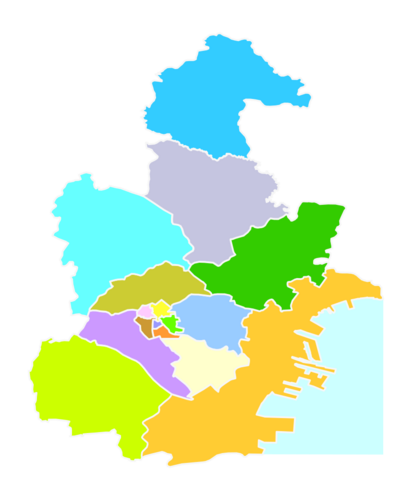
Heping
Hexi
Hebei
Nankai
Hedong
Hongqiao
Jizhou
Baodi
Ninghe
Binhai
Dongli
Jinnan
Xiqing
Beichen
Wuqing
Jinghai
|
||||||||||||||
| Division code | Division | Area in km2 | Total population 2010 | Urban area population 2010 |
Seat | Postal code | Subdivisions | |||||||
| Subdistricts | Towns | Townships | Ethnic townships | Residential communities | Villages | |||||||||
| 120000 | Tianjin | 11,760.00 | 12,938,693 | 10,277,893 | Hexi | 300000 | 112 | 118 | 10 | 1 | 1723 | 3762 | ||
| 120101 | Heping | 9.97 | 273,477 | Xiaobailou Subdistrict | 300041 | 6 | 63 | |||||||
| 120102 | Hedong | 15.06 | 860,852 | Dawangzhuang Subdistrict | 300171 | 13 | 158 | |||||||
| 120103 | Hexi | 41.24 | 870,632 | Dayingmen Subdistrict | 300202 | 13 | 171 | |||||||
| 120104 | Nankai | 40.64 | 1,018,196 | Changhong Subdistrict | 300110 | 12 | 180 | |||||||
| 120105 | Hebei | 29.14 | 788,451 | Wanghailou Subdistrict | 300143 | 10 | 109 | |||||||
| 120106 | Hongqiao | 21.30 | 531,526 | Xiyuzhuang Subdistrict | 300131 | 10 | 196 | |||||||
| 120110 | Dongli | 460.00 | 598,966 | 591,040 | Zhangguizhuang Subdistrict | 300300 | 9 | 90 | 102 | |||||
| 120111 | Xiqing | 545.00 | 713,060 | 524,894 | Yangliuqing town | 300380 | 2 | 7 | 106 | 151 | ||||
| 120112 | Jinnan | 401.00 | 593,063 | 590,072 | Xianshuigu town | 300350 | 8 | 68 | 165 | |||||
| 120113 | Beichen | 478.00 | 669,121 | 575,103 | Guoyuanxincun Subdistrict | 300400 | 5 | 9 | 115 | 126 | ||||
| 120114 | Wuqing | 1,570.00 | 951,078 | 352,659 | Yunhexi Subdistrict | 301700 | 6 | 24 | 64 | 695 | ||||
| 120115 | Baodi | 1,523.00 | 799,157 | 271,992 | Baoping Subdistrict | 301800 | 6 | 16 | 37 | 765 | ||||
| 120116 | Binhai | 2,270.00 | 2,423,204 | 2,313,361 | Xingang Subdistrict | 300451 | 19 | 7 | 254 | 144 | ||||
| 120117 | Ninghe | 1,414.00 | 416,143 | 152,388 | Lutai town | 301500 | 11 | 3 | 34 | 282 | ||||
| 120118 | Jinghai | 1,476.00 | 646,978 | 293,014 | Jinghai town | 301600 | 16 | 2 | 46 | 383 | ||||
| 120119 | Jizhou | 1,590.00 | 784,789 | 270,236 | Wenchang Subdistrict | 301900 | 1 | 20 | 5 | 1 | 32 | 949 | ||
| Divisions in Chinese and varieties of romanizations | ||||
|---|---|---|---|---|
| English | Chinese | Pinyin | ||
| Tianjin Municipality | 天津市 | Tiānjīn Shì | ||
| Heping District | 和平区 | Hépíng Qū | ||
| Hedong District | 河东区 | Hédōng Qū | ||
| Hexi District | 河西区 | Héxī Qū | ||
| Nankai District | 南开区 | Nánkāi Qū | ||
| Hebei District | 河北区 | Héběi Qū | ||
| Hongqiao District | 红桥区 | Hōngqiáo Qū | ||
| Dongli District | 东丽区 | Dōnglì Qū | ||
| Xiqing District | 西青区 | Xīqīng Qū | ||
| Jinnan District | 津南区 | Jīnnán Qū | ||
| Beichen District | 北辰区 | Běichén Qū | ||
| Wuqing District | 武清区 | Wǔqīng Qū | ||
| Baodi District | 宝坻区 | Bǎodǐ Qū | ||
| Binhai New Area | 滨海新区 | Bīnhǎi Xīnqū | ||
| Ninghe District | 宁河区 | Nínghé Qū | ||
| Jinghai District | 静海区 | Jìnghǎi Qū | ||
| Jizhou District | 蓟州区 | Jìzhōu Qū | ||
In 2017, Tianjin had a total population of 15.57 million people.
Tianjin's Economy and Industries

Tianjin's economy is very strong. In 2014, its total economic output was 1.572 trillion yuan. This was a 10% increase from the year before. Tianjin also had one of the highest per-person economic outputs in China.
The city has many important industries. These include making chemicals, textiles, and cars. It also has mechanical and metalworking industries. Big companies like EADS Airbus have factories here. The world's fastest supercomputer, Tianhe-1A, is in Tianjin.
| Skyscrapers in Tianjin | Meters | Feet |
|---|---|---|
| Goldin Finance 117 | 597 | 1,958.66 |
| Tianjin CTF Finance Centre | 530 | 1,738.85 |
| Tianjin Modern City Office Tower | 338 | 1,108.92 |
| Tianjin World Financial Center | 337 | 1,105.32 |
| TEDA IFC 1 | 313 | 1,026.9 |
| Jin Wan Plaza 9 | 300 | 984.25 |
| Yujiapu Yinglan International Finance Center | 299.45 | 982.45 |
| Powerlong Center Tower 1 | 289 | 948.16 |
| Bohai Bank Tower | 270 | 885.83 |
| Financial Street Heping Center | 263 | 862.86 |
| Century Metropolitan Mall | 258 | 846.46 |
| Tianjin China Life Financial Center | 251 | 823.49 |
Special Economic Zones
Tianjin has several special economic zones. These areas are set up to attract businesses and investments.
- Tianjin Economic-Technological Development Area (TEDA): This was one of the first zones approved by the government. It helps bring in new technology and modern industries.
- Tianjin Export Processing Zone: This is a special area where goods can be processed for export. Customs officials watch over goods entering and leaving.
- Tianjin Airport Economic Area: This zone is near the airport. It focuses on airfreight logistics. It's becoming a major airfreight hub in northern China.
- Tianjin Port Free Trade Zone: This is the only free trade zone in northern China. It's close to the port and airport.
- Tianjin Tanggu National Marine High-Tech Development Area: This area focuses on marine technology. It has many companies working on new materials and machinery.
- Tianjin Nangang Industrial Zone: This is a large area for heavy and chemical industries. It is designed to be a "circular economy" zone.

Farming and Resources
About 40% of Tianjin's land is used for farming. Important crops include wheat, rice, and maize.
Tianjin also has natural resources. There are large oil fields in the area. Salt production is another big industry. The city also has geothermal energy. Deposits of manganese and boron have been found here too.
People of Tianjin
| Historical population | ||
|---|---|---|
| Year | Pop. | ±% |
| 1953 | 2,693,831 | — |
| 1982 | 7,764,141 | +188.2% |
| 1990 | 8,785,402 | +13.2% |
| 2000 | 9,848,731 | +12.1% |
| 2010 | 12,938,224 | +31.4% |
| 2013 | 14,720,000 | +13.8% |
| Population size may be affected by changes on administrative divisions. | ||
At the end of 2009, Tianjin had about 12.28 million people. Most of them had permanent residency in the city. By 2013, the population grew to 14.72 million.
Most people in Tianjin are Han Chinese. However, people from many other ethnic groups also live here. Some of the larger minority groups include Hui, Korean, Manchu, and Mongol people.
| Ethnic groups in Tianjin, 2000 census | ||
|---|---|---|
| Ethnicity | Population | Percentage |
| Han | 9,581,775 | 97.29% |
| Hui | 172,357 | 1.75% |
| Manchu | 56,548 | 0.57% |
| Mongols | 11,331 | 0.12% |
| Korean | 11,041 | 0.11% |
| Zhuang | 4,055 | 0.041% |
| Tujia | 3,677 | 0.037% |
Media and News in Tianjin
Tianjin has its own radio and TV stations. Tianjin People's Broadcasting Station broadcasts on nine radio channels. It reaches over 100 million people. Tianjin Television also has nine TV channels.
Local newspapers include the Tianjin Daily and Jin Wan Bao. There are also English magazines for people from other countries. These include Jin, Tianjin Plus, and Business Tianjin.
Exploring Tianjin: Tourist Spots
Tianjin's streets show a mix of old and new. You can see 19th and early 20th-century European buildings. These stand next to modern glass skyscrapers. Many old buildings are protected.
In the 19th century, Western countries set up special areas in Tianjin. These were called concessions. The French built castles and towers. The Germans built red-tiled villas. These areas were like small European communities.
The old Chinese city walls were removed in the early 2000s. This made way for new buildings. Only a few old structures remain. One is the Tianjin Temple of Confucius.
Today, many interesting places for visitors are south and west of the central train station. These areas used to be the French and British concessions. You can still see their unique architecture.
Famous Places and Fun Things to Do
- Astor Hotel: A historic hotel.
- Binjiang Avenue: A popular shopping street.
- Dabei Monastery: A peaceful Buddhist temple.
- Drum Tower: An old tower in the city center.
- Five Main Avenues: An area with many old European-style buildings.
- Tianjin Italian Style Town: A charming area with Italian architecture.
- Goldin Finance 117: One of the tallest skyscrapers.
- Hai River Park: A nice park along the river.
- Memorial Hall: Dedicated to important figures like Zhou Enlai.
- Nanshi Cuisine Street: A great place to try local foods.
- People's Park: A large city park.
- St. Joseph's Cathedral of Tianjin: A beautiful Catholic church.
- Temple of Confucius Wen Miao: An ancient temple.
- Tianjin Ancient Culture Street: A street with traditional shops and crafts.
- Yuhuangge Taoist Temple: A Taoist temple on Culture Street.
- Tianjin Eye: A giant Ferris wheel over the Hai River.
- Tianjin Museum: Learn about Tianjin's history and culture.
- Tianjin Library: A modern library.
- Tianjin Binhai Library: Known for its unique design.
- Tianjin Art Gallery: See local and national art.
- Tianjin Natural History Museum: Explore nature and science.
- Tianjin Olympic Center Stadium: Also called "The Water Drop."
- Tianjin Radio and Television Tower: A tall tower with great views.
- Tianjin Water Park: A large park with lakes.
- Tianjin World Financial Center: Another tall building.
- Tianjin Zoo: Home to many animals.
- Yangliuqing: A town famous for traditional paintings.
- Porcelain House: A house covered in millions of porcelain pieces.
- Nankai University: A famous university.
- Tianjin University: China's first modern university.
Sights Outside the City Center
- Huangya Pass: A section of the Great Wall of China.
- Mount Panshan: A scenic mountain.
- Sino-Singapore Tianjin Eco-city: A project for sustainable living.
- Taku Forts: Historic forts near the coast.
- TEDA Football Stadium: Home to a professional football team.
Tianjin's Culture
People in Tianjin speak the Tianjin dialect. It's a type of Mandarin. Even though Beijing is close, the Tianjin dialect sounds different.
Tianjin is a key place for Beijing opera. This is a traditional Chinese art form.
The city is also known for its stand-up comedy, called xiangsheng. Famous comedians like Ma Sanli came from Tianjin. Xiangsheng often uses rhythmic bamboo clappers.
Yangliuqing is a town near Tianjin. It's famous for its colorful traditional paintings. These paintings are often made for Chinese New Year. Tianjin is also known for its Zhang clay figurines. These are colorful figures of different characters. The city's Wei's kites are also famous. They can be folded up small.
In 2015, the Juilliard School from New York opened a branch in Tianjin. It offers a master's degree program. This was the school's first big expansion outside the United States.
Delicious Tianjin Food
Tianjin cuisine focuses on seafood. This is because the city is close to the sea. The food can be simple, refined, or fancy.
Some famous dishes include the Eight Great Bowls. This is a set of eight main meat dishes. The Four Great Stews are also popular. They include many different kinds of stews.
The four most famous foods in Tianjin are:
- Goubuli baozi (steamed buns)
- Guifaxiang Shibajie Mahua (fried dough twists)
- Erduoyan Zhagao (fried rice cakes)
- Maobuwen Jiaozi (dumplings)
You can find these and other snacks at Nanshi Food Street.
Getting Around Tianjin
Tianjin has a very good transportation system. It's easy to get around. The city even won an award for its sustainable transport in 2024. This means it's good for the environment. The city has improved its walking, biking, and public transport options.
Tianjin's Airport
Tianjin Binhai International Airport is about 13 kilometers (8 miles) from the city center. It has a large terminal and long runways. Many airlines fly to Tianjin. It connects 48 cities, including 30 in China and 17 in other countries. Tianjin is also served by the new Beijing Daxing International Airport.
Tianjin Port
The Port of Tianjin is China's largest artificial deep-water harbor. It is one of the busiest ports in the world. It's a key port for international ships visiting the area.
Trams in Tianjin
Tianjin has a modern tram system in its Binhai/TEDA area. It was the first of its kind in China. Tianjin used to have an older tram network. It was built in 1904 and closed in 1972.
Tianjin Metro System
The Tianjin Metro is the city's subway system. It started service in 1984. It was the second subway built in China. The metro is still growing. It currently has six lines and 155 stations.
Rail Travel in Tianjin
Tianjin has several railway stations. The main one is Tianjin railway station. It was built in 1888. It's also called the 'East Station'. It has been rebuilt and modernized over the years.
Other stations include Tianjin West railway station and Tianjin North railway station. There are also stations in the port area.
A Beijing-Tianjin high-speed railway opened in 2008. It takes only 30 minutes to travel between Beijing and Tianjin.
Bus Services
As of 2005, Tianjin had over 900 bus lines. This makes it easy to travel around the city.
Roads and Expressways
Tianjin has many roads and expressways. Some roads have old names from the Republic of China era. Like other Chinese cities, some roads are named after provinces.
Tianjin has three ring roads. These help traffic flow around the city.
- Inner Ring Road
- Middle Ring Road
- Outer Ring Road
Seven expressways of China run in or through Tianjin. These connect the city to other major places. Six China National Highways also pass through Tianjin.
Religion in Tianjin
Some people in Tianjin practice traditional Chinese folk religions. They might worship Mazu, a sea goddess. Tianjin also has important religious buildings:
- Temple of Great Compassion: A Buddhist temple.
- St. Joseph's Cathedral: A Catholic church.
- Our Lady of Victory Church: Another Catholic church.
About 1.51% of the city's population are Christians. Tianjin has also been a strong center for Islam in China. There is a Muslim quarter in northwestern Tianjin. It has a Great Mosque built in 1703.
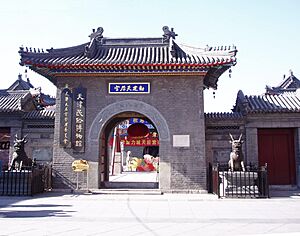
Sports in Tianjin
Sports teams in Tianjin include:
- Tianjin Jinmen Tiger FC: A professional football (soccer) team.
- Tianjin Lions: A baseball team.
- Tianjin Pioneers: A basketball team.
- Tianjin Bohai Bank women's volleyball team: A women's volleyball team.
Tianjin has hosted many big sports events. These include the 1995 World Table Tennis Championships and the 2013 East Asian Games. It also hosted the 2017 National Games of China. Since 2014, Tianjin has hosted an international women's tennis tournament.
Martial Arts in Tianjin
Tianjin and Beijing have been important centers for traditional Chinese martial arts for centuries. Some martial arts practiced here include bajiquan, piguazhang, xingyiquan, and baguazhang. Many martial artists practice in public parks like Xigu Park.
Learning in Tianjin: Schools and Universities
Colleges and Universities
Tianjin has many excellent universities. Some are managed by the national government:
- Tianjin University: Founded in 1895, it was China's first modern university.
- Nankai University: Founded in 1919, it is also very famous.
Many other universities are managed by the city government:
- Tianjin Academy of Fine Arts
- Tianjin Agricultural College
- Tianjin Medical University
- Tianjin Normal University
- Tianjin University of Science & Technology
- Tianjin University of Technology
There are also foreign universities with programs in Tianjin. The Tianjin Juilliard School is a branch of the famous Juilliard School in New York.
High Schools in Tianjin
Tianjin has many well-known high schools. Some of the most famous include:
- Tianjin Nankai High School
- Tianjin No. 1 High School
- Tianjin Yaohua Middle School
- Tianjin Xinhua High School
- Tianjin Experimental High School
Famous People from Tianjin
Many notable people were born in or lived in Tianjin.
- Hou Baolin: A famous stand-up comedian.
- Wen Jiabao: A former Premier of China.
- Eric Liddell: An Olympic gold medalist runner.
- Adeline Yen Mah: A Chinese-American author.
- Yu Min: A nuclear physicist, known as "the father of the Chinese Hydrogen Bomb."
- Peng Shuai: A professional female tennis player.
- Huo Yuanjia: A famous Chinese martial artist.
Sister Cities Around the World
Tianjin has many sister cities around the world. These partnerships help build friendships and cultural exchange.
 Kobe, Japan
Kobe, Japan Chiba, Japan
Chiba, Japan Incheon, South Korea
Incheon, South Korea
 Mobile, Alabama, United States
Mobile, Alabama, United States
 Fitchburg, Massachusetts, United States
Fitchburg, Massachusetts, United States
 Philadelphia, Pennsylvania, United States
Philadelphia, Pennsylvania, United States
 Melbourne, Australia
Melbourne, Australia Bangkok, Thailand
Bangkok, Thailand Phnom Penh, Cambodia
Phnom Penh, Cambodia Pyongyang, North Korea
Pyongyang, North Korea Sarajevo, Bosnia and Herzegovina
Sarajevo, Bosnia and Herzegovina Abidjan, Côte d'Ivoire
Abidjan, Côte d'Ivoire Groningen, the Netherlands
Groningen, the Netherlands Rishon LeZion, Israel
Rishon LeZion, Israel İzmir, Turkey
İzmir, Turkey Haiphong, Vietnam
Haiphong, Vietnam Singapore
Singapore Mar del Plata, Argentina
Mar del Plata, Argentina Larnaca, Cyprus
Larnaca, Cyprus Jönköping, Sweden
Jönköping, Sweden Thessaloniki, Greece
Thessaloniki, Greece Cali, Colombia
Cali, Colombia
Images for kids
See also
 In Spanish: Tianjin para niños
In Spanish: Tianjin para niños









